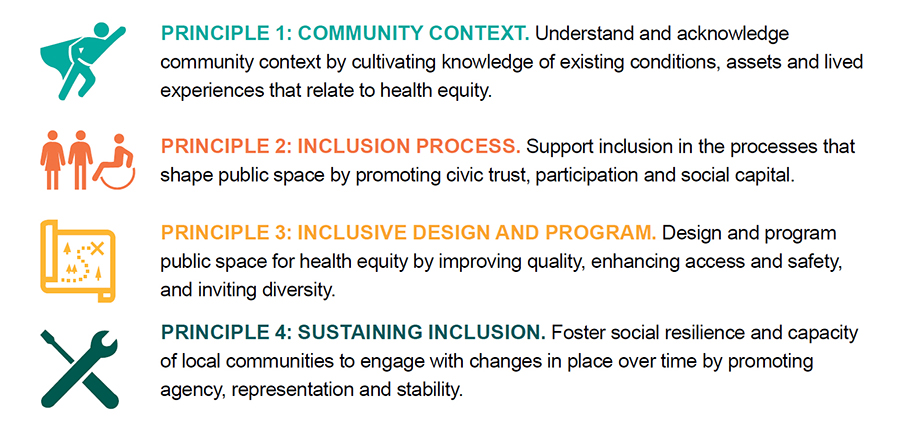
Pictured: City of Perris, California, hosts a community engagement event at Cooper Creek Park. Photo courtesy of City of Perris.
On a sunny, warm Saturday afternoon, I decided to strap the harness on my dog, Apollo, and walk to our local park in Northern Virginia. On our walk, I took note of the smooth, well-connected sidewalks and the visible, easy-to-read signs leading to a short .25-mile trail that brought us to the park space. The park has soccer fields, trails that wind along the banks of Bull Run, a small playground, picnic tables, restrooms, a small parking lot, and signage of the cultural and natural history of the place. On this Saturday afternoon, it seemed everyone was taking advantage of a low-humidity, warm Virginia day to walk the trails, climb on the jungle gym, and play soccer or be a supportive family member on the sidelines. Looking a little closer, though, I could see some signs for improvement – cars circling the full parking lot, a crowded playground, umbrellas to protect from the hot sun, a long line at the water fountain. I sat down under a tree to take a drink of water and asked myself, “is this an inclusive, healthy place?”
Being in parks and recreation, I often think about park access and quality when I visit a space. In my community, like many urban and suburban areas in the South, we’re seeing a lot of development and growth and an increase in multi-cultural, multi-racial communities. This area is predominantly middle-income, renters and young professionals with small families — either kids or, in my case, Apollo. We see the stress of yesterday’s demands in meetings today’s needs. So, how can park and recreation professionals ensure spaces are meeting the needs of evolving communities? What are the metrics and indicators to reference to ensure the space is inclusive of the surrounding community and supports a healthy lifestyle? Our partners at Gehl created the Inclusive Healthy Places Framework to provide a one-stop-shop of these indices and show how professionals can integrate them into the evaluation of the planning, development, programming and stewardship of a park and recreation space.
In 2021, Crawford County, Arkansas, and Perris, California, put the framework to the test. They each identified one park space and used the framework to evaluate if these spaces are meeting the needs of the surrounding community. Looking at the four principles of the framework, they chose which ones were most applicable and achievable for them:

For Crawford County, this meant looking at principles one, two and three. Centered on these principles, the project team created a survey and used the Our Voice app for community members to travel to and around the space and record observations with photos, comments and emojis on the access to and quality of the space. The team used this approach to better understand the predictors of exclusion, the characteristics of people who were present in the space, understanding who is at the decision-making table and the quality of the space.
In Perris, the team took a similar approach in developing a survey but focused on the principles that matched where they are in the evaluation of the space. Focusing on principles one and three, the Perris team measured demographics to increase diverse representation of parks users, measured walkability to evaluate transportation needs, and measured user health by level of physical activity, healthy eating and chronic disease. As a result, the team reinvigorated a marketing campaign, #PerrisParksMakesLifeBetterforAll.
This tool is about shifting power away from decisions based on the priorities of elected officials and equips park and recreation professionals with a common language to collect, measure and lift up community priorities. In Perris, the team presented the findings from their survey to the park and recreation commission for how they should prioritize funding, and Crawford County plans to do the same.
From the two experiences of these communities, NRPA developed the Inclusive Healthy Places Companion Guide for Park and Recreation Professionals to focus the content of Gehl’s Framework for the usability of park and recreation professionals. No matter where you are in the evaluation process of a park and recreation space, this companion guide provides a framework to ensure you are meeting the community’s needs. Use the examples from Crawford County and Perris:
- Start with one park.
- Use the framework and companion guide to identify gaps in your agency’s data collection.
- Once you’ve identified the principles, metrics and indicators that are right for you, do community engagement – surveys, events, walk audits, etc. Reference NRPA’s Community Engagement Resource Guide for meaningful ways to engage the community.
- Take those results and create a report to share with the decision-makers in your agency.
- Use this as a model and apply it to other park and recreation spaces.
This resource is an opportunity for your agency to center the community in its decision-making and create systemic change that will lead to more equitable, inclusive, healthy and resilient park spaces. How do you plan to use this framework to create a more equitable park system?
Jared Mummert (he/him) is a program manager for community and environmental resilience at NRPA.

